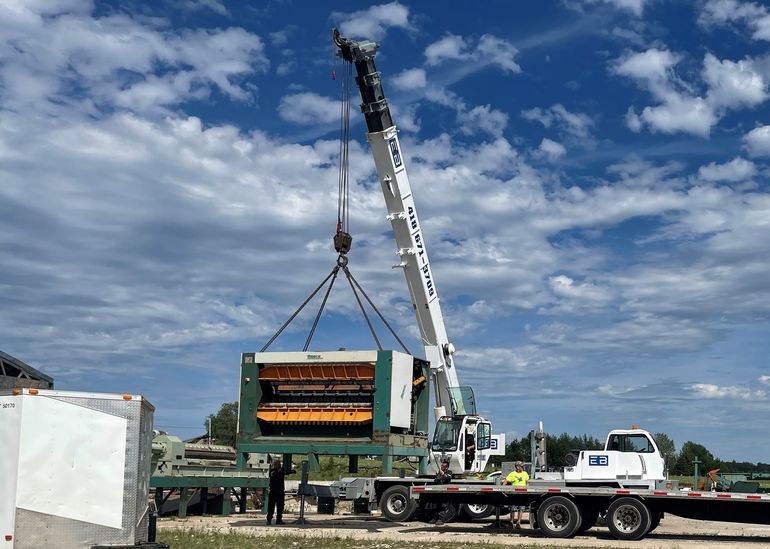Effort to build plywood plant in Somerset County still needs funding
 Courtesy / Charlie Martin
An industrial-sized lathe being unloaded at the Bingham site of Maine Plywood USA.
Courtesy / Charlie Martin
An industrial-sized lathe being unloaded at the Bingham site of Maine Plywood USA.
Maine has been in a building boom in the past several years, but among the products that have to be shipped in is plywood — which is used in nearly every type of structure, from houses to commercial buildings, as part of the roof and in the subflooring.
In the first year of the pandemic, the cost of a sheet of plywood quadrupled, according to the USDA Forest Service. And for contractors in Maine, every sheet of plywood they use has to be shipped from the Pacific Northwest.
Maine has not had a plywood factory in more than four decades, yet it has most of the raw materials right here.
A Chicago businessman, Charlie Martin, has been quietly trying to establish plywood factory in Somerset County that he says would employ more than 100 people.
Martin, who has specialized in flooring products for three decades, has invested $1 million of his own money to convert the former Quimby mill in Bingham to a plywood factory, Maine Plywood USA LLC.
The Quimby sawmill, north of Skowhegan, was once a major employer, but has been vacant for years.
He said they spent $30,000 on Dumpsters just to haul out the old junk. Weeds and trees had to be cut down. Some of the roofs had to be repaired.
“I didn’t appreciate how much work it would take to fix up the old plant,” Martin said. But overall, “some of the buildings can withstand a tornado. They are so well built.”
Martin found a shuttered plywood factory in Canada and bought its machinery, including an industrial-sized lathe weighing 35,000 pounds.
"We filled 23 trucks bringing [the machinery] to Maine," he said.
Plywood's long journey
For now, all plywood used in Maine comes from the Pacific Northwest. Russia used to supply some of the plywood used in the U.S., but with the Ukraine situation imports have been curtailed. Asian plywood has filled some of that void, but also become more expensive.
No matter where plywood comes from there, there’s the shipping expense. Containers that used to cost $3,000 from Asia now cost $18,000, Martin said.
Most plywood that comes from the Pacific Northwest is brought by train and then trucked to individual lumber yards.
Martin wants to provide local plywood and says Maine has an abundance of poplar that is mostly just used by paper mills as pulp.
The Maine Plywood operation projects using 80,000 to 100,000 tons of poplar per year to make plywood, and anticipates buying wood from logging operations in Maine and elsewhere in New England, providing the added benefit of helping the logging industry.
But without private equity backing, Martin has found little support among local banks or funding organizations. He said he had business contacts in Canada, but in the end decided he liked the idea of U.S. manufacturing — and that led him to Maine, with its abundant natural resources.
Somerset County has granted $50,000 to Maine Plywood USA in conjunction with $100,000 SEDC loan approval from TIF funds. The Future Forest Economy initiative made a $369,000 grant to the Somerset Economic Development Corp., which was earmarked for dryer equipment that it could lease to Maine Plywood USA.
But the project will likely need private equity funding to get over the hump. One of the issues, he said, is investors prefer investing in something that is running and not a startup.
Much of the machinery needed to manufacture plywood is already in the plant. An experienced company is putting it all together but it takes a lot of time and money, he said.
“We are building a plywood plant in Maine not because it is easy — because it is not. But it’s not rocket science either,” Martin said.










0 Comments